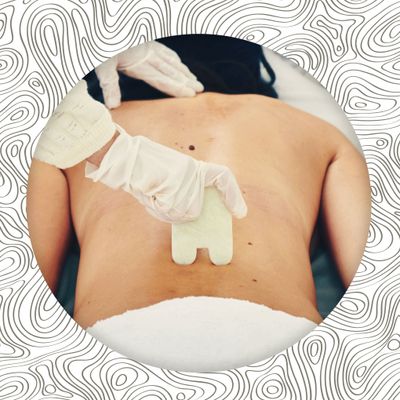
I learned about gua sha in a roundabout way: I like to watch ASMR videos on YouTube, and some of my favorites are ones in which a host massages her guest’s face and neck with a blunt stone tool.
Eventually, I figured out that this was a much gentler version of the traditional Chinese therapy, in which a practitioner applies vigorous surface friction to lubricated skin — frequently on the back and neck — with a rounded tool, often to the point of dramatic, mottled bruising. Also known as coining, spooning, and scraping, gua sha is commonly used in Asia to treat chronic pain and respiratory ailments; one Chinese translation is “scraping out the wind.” In the images I saw, the bruising looked painful, but overall the effect was also inviting. I didn’t have chronic pain, but I was curious, so I made an appointment.
To prepare, I spoke with Dr. Victoria Chan Harrison, MD, a rehabilitation medicine specialist at Columbia and Weill Cornell. “Gua sha predates modern medicine, so some call it a folk remedy,” she told me, “but early promising research does support its use for chronic pain.” Small studies have shown that gua sha can improve chronic neck pain, for instance, and that it can alleviate breast engorgement in postpartum women, by improving lymphatic drainage and decreasing swelling. Critics have argued that gua sha’s benefit may be due to the placebo effect, but this is hard to rule out, Harrison noted, given the challenge of creating a double-blind scenario in which neither the patients nor the practitioners know whether they’re giving or receiving gua sha. And although the marks are dramatic, she said, they typically fade within a week.
How does gua sha work to alleviate pain? I asked. Harrison told me that the physiological mechanisms “are still currently under investigation,” but that the latest evidence points to gua sha’s anti-inflammatory and circulatory properties: It can trigger the release of an anti-inflammatory enzyme with cell-protective effects, she explained, and it can boost blood flow up to 400 percent throughout the treated area, which can result in “immediate and sustained post-treatment pain relief.” It can also result in a thermal change in the skin, she added, so patients may feel physically warm during and after treatment.
I asked her about the gentler form of gua sha, like the kind I’d seen in the ASMR videos, which has become popular both as an in-clinic treatment and in online DIY tutorials. She was skeptical: “It’s hard to say that gentle facial gua sha will definitely work” in the same way as traditional gua sha, she said, “because it doesn’t trigger the signature red-and-purple skin changes.” But she suggested that this gentler gua sha might have more in common with jade roller facial massage, noting that this type of treatment has its own benefits.
At my appointment, lying face-down on the practitioner’s table (most acupuncturists have also trained in gua sha), I was expecting the scraping to hurt a little, but once she poured the herb-infused oil on my back and started the treatment — scraping my skin with a sterilized buffalo/ox horn tool — the pressure was pleasant and welcome, and I wished it went on for longer. It wasn’t as painful as an intense massage, for comparison, and I especially liked when she went over my ribs and the fleshy parts on my shoulders. She told me that gua sha doesn’t always raise the signature bruises, and that the bruising happens more when a person has a lot of pain to deal with, whether it’s emotional or physical. (According to traditional Chinese medicine, the bruising can correspond with where and what kind of pain a person has.) My session didn’t raise many “sha” marks, although that squared with my relative lack of pain going in.
Well, I loved it. I don’t know what it did, if anything, but as with acupuncture, it felt wonderful to have someone paying attention to me in that way. And it did feel warm, which was a nice feeling to carry with me afterward. Three days later, the bruises on my back — more like sprinkles of red dots — had fully faded, although the session lingered in mind for longer.





